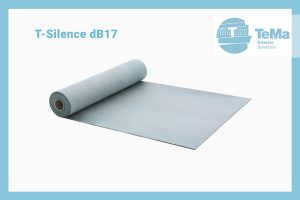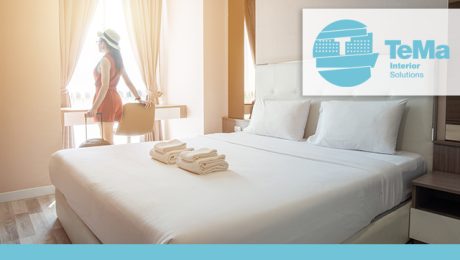Hotels and acoustic comfort
Acoustic well-being is a must in hotels.
In the competitive hospitality industry, guest satisfaction hinges on details—especially peace and quiet. Yet, hotels, resorts, and high-traffic spaces often grapple with noise complaints: clattering footsteps in hallways, chair scrapes in dining areas, and echoes in lobbies. These disturbances don’t just irritate guests—they damage reviews and repeat business.
From luxury suites to banquet halls, noise transfer is a pervasive challenge:
- Impact noise: Footsteps, dropped items, and moving furniture transmit vibrations through floors.
- Airborne noise: Conversations, music, and HVAC systems travel through walls and floors.
- Regulatory pressures: Many EU countries enforce strict noise regulations.
In Italy, for example, speaking of acoustic comfort and governing its implementation is Prime Ministerial Decree of 5/12/97, which establishes the limit values, calculation methods and requirements to be achieved in order to reduce exposure to excessive noise.
Traditional solutions like thick carpets or floating floors often fall short, compromising aesthetics and are source of problems from a health and hygiene point of view.
A solution for footfall noise that does not require intervention on the screed.
T-Silence offers excellent acoustic insulation performance and can be applied under any finish, including wood, PVC, ceramic tiles and stone, without damaging the existing screed.
For under-tile applications T-Silence dB17, membrane roll consisting of a polymeric sheet bonded on one side to a resilient polypropylene non-woven fabric, and on the other side to a spunbonded fabric, is designed to be installed on a screed under the tiles and then covered with cementitious glue and the desired tiles or wood.
T-Silence absorbs up to 17 dB of noise in just 2,5 mm (0.1 in).

Why hotels choose it
- Aesthetic Flexibility: install under tiles, wood, or stone without altering design plans.
- Space-Saving: thin profile preserves ceiling height—critical for renovations.
- Durability: waterproof and mold-resistant, ideal for bathrooms, spas, and pool areas.
- Quick Installation: pre-rolled sheets adhere directly to screed or flooring, cutting labor time
Conclusion: the sound of success
In an era where silence is a premium commodity, soundproofing membranes like T-Silence DB-17 offer hotels a competitive edge. By merging acoustic performance with design freedom, they turn noise-prone spaces into oases of calm—ensuring guests remember their stay for the right reasons.
- Published in Acoustic insulation, Acoustic insulation system - under tile, Acoustic insulation systems - under screed, INTERIOR
Dry Renovation: a Quick and Clean Method
At an historic moment in time when everything is coming to a halt, we must not forget that we still have ways to increase our knowledge and get ready for the time when everything gets back to normal. The home, for obvious reasons, is now the focus of our thoughts. The more days go by, the more we notice some jobs that have been left aside for too long: a basement to be fixed, a wall to be better insulated or a terrace floor to be changed because it is excessively damaged. So let’s discover something more about one of the ways to renovate those parts of the home that require our attention.
Dry renovation: a valid solution
The dry renovation system is a processing method that does not involve the use of water, adhesives or sealants that need to remain in place to dry. Although Italy has always opted for the so-called wet clay-cement system, this does not mean that new methods have not recently been explored. This traditional work method was cast aside during the years of crisis in Italy in the building industry, since it focused on protecting the existing heritage and, therefore, on renovating rather than building from scratch.
Renovating, synonymous with saving
After all, renovating becomes synonymous with energy efficiency. You save on your bills and gain in terms of wellbeing and living comfort, primarily by enhancing the value of your property. The dry installation system, which can be applied to the outside of a building, to its structure or to its internal system, offers many advantages.

We talk about the eco-sustainability of new materials, because they can be recycled, replaced if damage or deterioration occurs, and even re-used. Moreover, dry renovation allows much quicker intervention times and more sustainable situations because tenants do not need to leave their homes during intervention works.
The materials and method used by TeMa
In the specific context of TeMa Interior, the division dedicated to floors, balconies and terraces, soundproofing and waterproofing membranes are used that are easily shaped and transported because of their minimal weight.

Combined with dry installation, these materials allow short intervention times and greatly reduced costs. But remember that this does not entail any reduction in the performance of the intervention work. The final cost of any intervention will be lower because the thickness of the membranes is reduced and, consequently, the quantity of the materials used.
It is precisely the materials, with their physical properties and excellent performance, that ensure the efficiency of intervention work, first and foremost by facilitating the procedures involved.
To find out about all our applications, visit our website.
A new wellbeing range
As humans, one of our basic needs is to create a nest that is warm and dry, and protected from bad weather conditions, hoping that a woodpecker will not come along and live above this nest. Unfortunately, we do not always realise that what affects people’s wellbeing is not only the pleasure of the warmth that an isolated environment brings, but also the silence.
Silence has only recently been re-evaluated as a category
Silence has only recently been re-evaluated as a category of wellbeing. Modern culture has allowed it to be acknowledged as a pre-requisite for a peaceful life. The concept of health has extended its boundaries to include other areas such as noise, which, together with other factors such as light and temperature, influences people’s good living. The World Health Organization (WHO) defines the concept of health as “a state of complete physical, mental and social wellbeing and not merely the absence of disease or infirmity.” Enjoying good sound insulation in the home is therefore not an extra but a necessity. This is why TeMa Interior decided to create T-Silence to reduce footfall noise.

T-Silence, a universally valid option
To make T-Silence a universally valid option, Tema decided to use materials with narrow thicknesses, minimally invasive intervention methods and reduced on-site installation times. In this way, those who are building from scratch or renovating and those who already live in a building and cannot leave it temporarily can make use of the system. Dry applications are used that do not require new screeds and therefore a drying cycle is not necessary. A further advantage not to be overlooked is the option of applying T-Silence without demolishing the existing floor and/or the screed below. This avoids any inconvenience for tenants and ensures quick installation.

So, what is the advantage of soundproofing your home? You can achieve your own wellbeing.
Silence will accompany your daily routine, aiding concentration and avoiding any change in your mindset that normally leads to anxiety, depression and discontent. In the evenings, you will have no problem falling asleep, you will not be woken up in the middle of the night by noisy neighbours and you will allow your brain to re-work the stimuli collected during the day and peacefully fix your memories. Sleep considerably affects everyone’s ability to concentrate and promotes growth processes, which is why it should not be underestimated.
This is why a system like T-Silence becomes essential: because it preserves, protects and enhances your wellbeing. Spread the word and tell the neighbours above you and think about those below you.
If you want to learn more and discover the T-Silence application methods, browse the CATALOGUE.




